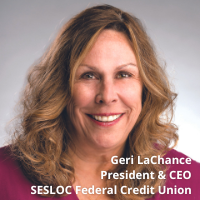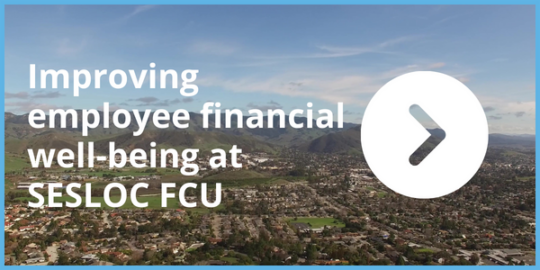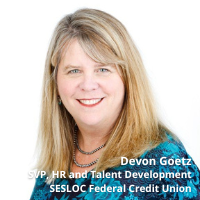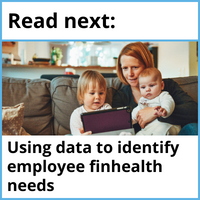Financial well-being as an organizational goal: moving the needle on credit union employees’ financial health

How a credit union based in one of the nation’s most expensive cities integrated financial well-being into its strategy.
When your credit union is located in the second least affordable metro area in the U.S.—one where the median home price tops a cool $1 million—you tend to be aware that folks might be struggling financially. And not just your members.
 “Having to sign employees’ hardship withdrawal paperwork on their 401(k)s really brought the point home,” said Geri LaChance, president/CEO of SESLOC Federal Credit Union in San Luis Obispo, California. “It was truly heartbreaking to realize the degree to which employees were struggling. I knew something had to change.”
“Having to sign employees’ hardship withdrawal paperwork on their 401(k)s really brought the point home,” said Geri LaChance, president/CEO of SESLOC Federal Credit Union in San Luis Obispo, California. “It was truly heartbreaking to realize the degree to which employees were struggling. I knew something had to change.”
Making employee financial well-being an organizational priority
“I’ve worked in credit unions a long time. As a movement, we pride ourselves on that ‘people helping people’ philosophy but when you look around, there are perhaps greater financial disparities than ever before,” said LaChance.
“The National Credit Union Foundation is opening the system’s eyes to how we can make the Credit Union Difference tangible: by placing financial well-being at the core of our strategy. For us, we knew that first step had to support our own employees.”
 Each year, SESLOC chooses one organizational goal that all employees are tasked with. For 2021, it was improved employee financial well-being.
Each year, SESLOC chooses one organizational goal that all employees are tasked with. For 2021, it was improved employee financial well-being.
One step was raising salaries—marketplace realities demanded it and SESLOC has always worked hard to keep its wages at market value. But LaChance knew money was just one piece of the puzzle.
The financial well-being model endorsed by the Foundation considers four key areas: Control, Capacity, Choice and Goals. When viewed through these filters, an individual’s financial health becomes as much about how they feel about their money as how they use it.
“We knew we had to improve employees’ sentiment around their money,” added LaChance. “It wasn’t just the amount of it, but their ability to control it. To have and achieve goals.”
Require every employee to do three things
 SESLOC created a list of activities designed to improve personal financial health. Over the course of 2021, each employee—including Geri herself—was required to complete three specific financial health activities.
SESLOC created a list of activities designed to improve personal financial health. Over the course of 2021, each employee—including Geri herself—was required to complete three specific financial health activities.
Employees chose from the list or defined their own goals. They could opt for three different items or do the same item multiple times. Some activities were very simple (reading informative, educational articles), others were more challenging; like starting to participate in SESLOC’s 401(k) or creating an emergency savings fund.
As an enterprise goal, each employee documented their activities in SESLOC’s performance management system and shared what they learned.
From heart-wrenching to heartwarming
SESLOC was cautiously optimistic going into the program. The results far exceeded their expectations.
Roughly 15% of employees increased their 401(k) contributions by at least 1%; others began to contribute for the very first time. Another popular choice: emergency funds.
 “That really blew us away,” said Devon Goetz, SESLOC’s SVP human resources and talent development. “We had employees with no savings at all who managed to save at least $400 by the end of the year—and many saved quite a bit more.”
“That really blew us away,” said Devon Goetz, SESLOC’s SVP human resources and talent development. “We had employees with no savings at all who managed to save at least $400 by the end of the year—and many saved quite a bit more.”
Equally impressive were the comments employees shared. Many wrote about tracking their spending—and being shocked at how much they’d spent on frivolous purchases they really couldn’t afford. Others talked about their excitement at creating a budget for the first time and the pride they felt when they stuck to it.
“Our employees wrote so sincerely about what they learned and how this benefited them and their families,” shared Goetz. “It was a bit heart-wrenching to learn how much some of them had struggled, then so rewarding to see how excited they were about the changes they’d made.”
Secrets to program success
 Accountability is a well-established way to be successful in achieving a goal and played a big role in program results. But something else was just as important: normalizing conversations about financial struggles.
Accountability is a well-established way to be successful in achieving a goal and played a big role in program results. But something else was just as important: normalizing conversations about financial struggles.
“Who wants to tell their co-workers or their manager they’re having a hard time financially?” asked LaChance. “This program helped employees see they weren’t alone. That it was ok to talk about your challenges and there were active steps you could take to get in a better place.”
Goetz added, “It’s part of the DNA of a credit union to do the right thing. Sometimes we need to remind ourselves, that means supporting our members and our employees on their financial journey. It means a lot to our employees, to me personally, to see SESLOC’s strategic commitment to this.”


